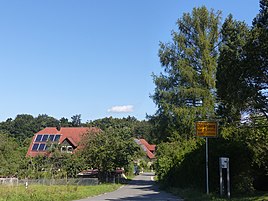Dietersberg (Egloffstein)
|
Dietersberg
Egloffstein market
Coordinates: 49 ° 41 ′ 51 ″ N , 11 ° 15 ′ 24 ″ E
|
|
|---|---|
| Height : | 456 (450–461) m above sea level NHN |
| Residents : | 16 (1987) |
| Postal code : | 91349 |
| Area code : | 09197 |
|
The Egloffsteiner district Dietersberg
|
|
Dietersberg is a Franconian hamlet that belongs to Egloffstein .
geography
In the southwest of the Wiesentalb preferred Weiler is one of 16 officially designated districts in the upper Franken located market Egloff stone. It is located about half a kilometer southwest of the center of Egloffstein and is at an altitude of 456 m above sea level. NHN . Dietersberg is located on the north-eastern edge of a high plateau belonging to the Northern Franconian Jura, which is bounded in the northeast by the Trubach and in the southwest by the upper reaches of the Schwabach .
history
Until the beginning of the 19th century Dieter Berg had the rule rich immediate subordinate to nobleman, located in the the Frankish knights circle belonging Ritter Canton Gebürg had organized. The place formed part of the manor Egloffstein and was thus owned by the barons of Egloffstein . This stood by the bailiwick to the village, also they practiced also in Franconia for the sovereignty authoritative village and township rule out. The high courts , however, was controversial, it was the one from which the Principality of Bayreuth belonging Bailiwick Office Thuisbrunn in his role as Fraischamt claimed and the other of which to the Bishopric of Bamberg belonging Office Ebermannstadt in his capacity as cents Office . When the imperial knighthood territories in Franconian Switzerland were mediatized in 1805 , the hamlet was annexed by the Electorate of Palatinate-Baiern in violation of the imperial constitution . With this forcible takeover, Dietersberg also became part of the New Bavarian territories that were occupied during the Napoleonic land consolidation , which was only subsequently legalized in July 1806 with the Rhenish Federal Act .
Due to the administrative reforms carried out in the Kingdom of Bavaria at the beginning of the 19th century , Dietersberg became part of the independent rural community of Egloffstein with the second municipal edict in 1818, which also included the village of Egloffsteinerhüll , the hamlet of Mostviel and the desert of Leithen . In 1987 Dietersberg had 16 residents.
traffic
The only connection to the public road network is made by a community road, which branches off about one kilometer west-southwest of the village from the district road FO 32 and ends on the northern edge of the hamlet. The center of Egloffstein, only half a kilometer away, can be reached from Dietersberg via two steeply sloping footpaths, neither of which are paved.
Ossi Bühler Hut
At the southern end of the hamlet is the Ossi-Bühler-Hütte , named after the Nuremberg mountaineer and book author Oskar Bühler , a self-catering hut that is normally only made available to members of the Nuremberg Alpine Club Section.
Attractions

In Dietersberg there are two listed objects, namely a Zehntstadel in the northeastern local area and the ruins of the former parish church of the Holy Three Kings, which are a little out of town .
literature
- Ingomar Bog: Forchheim . In: Historical Atlas of Bavaria . Commission for Bavarian State History, Munich 1955.
- Gertrud Diepolder : Bavarian History Atlas . Ed .: Max Spindler . Bayerischer Schulbuch Verlag, Munich 1969, ISBN 3-7627-0723-5 .
- Federal Statistical Office (Hrsg.): Historical municipality register for the Federal Republic of Germany. Name, border and key number changes in municipalities, counties and administrative districts from May 27, 1970 to December 31, 1982 . W. Kohlhammer, Stuttgart / Mainz 1983, ISBN 3-17-003263-1 .
Web links
- Bavarian authorities guide for Dietersberg , accessed on September 9, 2019
- Dietersberg in the BayernAtlas , accessed on September 9, 2019
- Dietersberg on a historical map , accessed on September 9, 2019
Individual evidence
- ↑ a b Bavarian State Office for Statistics and Data Processing (Ed.): Official local directory for Bavaria, territorial status: May 25, 1987 . Issue 450 of the articles on Bavaria's statistics. Munich November 1991, DNB 94240937X , p. 301 ( digitized version ). Retrieved September 8, 2019
- ^ Dietersberg in the local database of the Bayerische Landesbibliothek Online . Bavarian State Library, accessed on September 9, 2019.
- ↑ Geographical location of Dietersberg in the Bayern Atlas , accessed on September 9, 2019
- ↑ Gertrud Diepolder : Bavarian History Atlas . Ed .: Max Spindler . Bayerischer Schulbuch Verlag, Munich 1969, ISBN 3-7627-0723-5 , p. 31 .
- ↑ Gertrud Diepolder : Bavarian History Atlas . Ed .: Max Spindler . Bayerischer Schulbuch Verlag, Munich 1969, ISBN 3-7627-0723-5 , p. 97-103 .
- ^ Ingomar Bog: Forchheim . In: Historical Atlas of Bavaria . S. 40 .
- ↑ a b Ingomar Bog: Forchheim . In: Historical Atlas of Bavaria . S. 114-115 .
- ^ Ingomar Bog: Forchheim . In: Historical Atlas of Bavaria . S. 47 .
- ^ Ingomar Bog: Forchheim . In: Historical Atlas of Bavaria . S. 22 .
- ^ Ingomar Bog: Forchheim . In: Historical Atlas of Bavaria . "Hochgerichtkarte" card supplement .
- ↑ Gertrud Diepolder : Bavarian History Atlas . Ed .: Max Spindler . Bayerischer Schulbuch Verlag, Munich 1969, ISBN 3-7627-0723-5 , p. 35 .
- ↑ Gertrud Diepolder : Bavarian History Atlas . Ed .: Max Spindler . Bayerischer Schulbuch Verlag, Munich 1969, ISBN 3-7627-0723-5 , p. 106-107 .
- ↑ Bavarian State Statistical Office (ed.): Official city directory for Bavaria, territorial status on October 1, 1964 with statistical information from the 1961 census . Issue 260 of the articles on Bavaria's statistics. Munich 1964, DNB 453660959 , Section II, Sp. 673 ( digitized version ). Retrieved September 04, 2019

